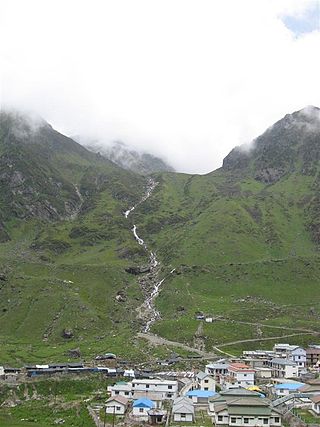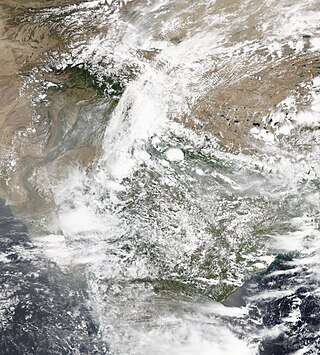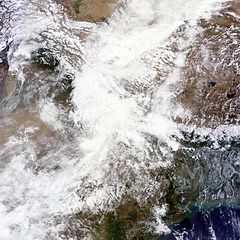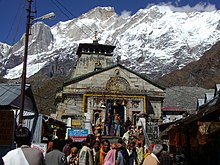
Badrinath is a town and nagar panchayat in Chamoli district in the state of Uttarakhand, India. It is a Hindu holy place, and is one of the four sites in India's Char Dham pilgrimage. It is also part of India's Chota Char Dham pilgrimage circuit and gets its name from the Badrinath Temple.

Kedarnath is a town and Nagar Panchayat in Rudraprayag district of Uttarakhand, India, known primarily for the Kedarnath Temple. It is approximately 86 kilometres from Rudraprayag, the district headquarter. Kedarnath is the most remote of the four Chota Char Dham pilgrimage sites. It is located in the Himalayas, about 3,583 m (11,755 ft) above sea level near the Chorabari Glacier, which is the source of the Mandakini river. The town is flanked by snow-capped peaks, most prominently the Kedarnath Mountain. The nearest road head is at Gaurikund about 16 km away. The town suffered extensive destruction during June 2013 from the Flash Floods caused by torrential rains in Uttarakhand state.

A cloudburst is an extreme amount of precipitation in a short period of time, sometimes accompanied by hail and thunder, which is capable of creating flood conditions. Cloudbursts can quickly dump large amounts of water, e.g. 25 mm of the precipitation corresponds to 25,000 metric tons per square kilometre. However, cloudbursts are infrequent as they occur only via orographic lift or occasionally when a warm air parcel mixes with cooler air, resulting in sudden condensation. At times, a large amount of runoff from higher elevations is mistakenly conflated with a cloudburst. The term "cloudburst" arose from the notion that clouds were akin to water balloons and could burst, resulting in rapid precipitation. Though this idea has since been disproven, the term remains in use.
The Chota Char Dham is an important Hindu pilgrimage circuit in Uttarakhand, in the Indian Himalayas. Located in the Garhwal region of the state of Uttarakhand, the circuit consists of four sites—Gangotri, Yamunotri, Kedarnath, and Badrinath. Badrinath is also one of the four destinations of the longer Char Dham from which the Chota Char Dham likely draws its name.

The Mandakini River is a tributary of the Alaknanda River in the Indian state of Uttarakhand. The river runs for approximately 81 kilometres (50 mi) between the Rudraprayag and Sonprayag areas and emerges from the Chorabari Glacier. The Mandakini merges with river Songanga at Sonprayag and flows past the Hindu temple Madhyamaheshwar at Ukhimath. At the end of its course it drains into the Alaknanda, which flows into the Ganges.

Badarinath or Badarinarayana Temple is a Hindu temple dedicated to Vishnu. It is situated in the town of Badrinath in Uttarakhand, India. The temple is also one of the 108 Divya Desams dedicated to Vishnu—holy shrines for Vaishnavas—who is worshipped as Badrinath. It is open for six months every year, because of extreme weather conditions in the Himalayan region. The temple is located in Garhwal hill tracks in Chamoli district along the banks of Alaknanda River. It is one of the most visited pilgrimage centers of India, having recorded 2.8 million visits in just 2 months in 2022. It is one of the Char Dham pilgrimage sites.

Kedarnath Temple is a Hindu temple, one of the twelve jyotirlinga of Shiva. The temple is located on the Garhwal Himalayan range near the Mandakini river, in the state of Uttarakhand, India. Due to extreme weather conditions, the temple is open to the general public only between the months of April and November. During the winters, the vigraha (deity) of the temple is carried down to Ukhimath to be worshipped for the next six months. Kedarnath is seen as a homogeneous form of Shiva, the 'Lord of Kedarkhand', the historical name of the region.

Yatra, in Indian-origin religions, Hinduism, Buddhism, Jainism and Sikhism, generally means a pilgrimage to holy places such as confluences of sacred rivers, sacred mountains, places associated with Hindu epics such as the Mahabharata and Ramayana, and other sacred pilgrimage sites. Visiting a sacred place is believed by the pilgrim to purify the self and bring one closer to the divine. The journey itself is as important as the destination, and the hardships of travel serve as an act of devotion in themselves.
Kedarnath Wild Life Sanctuary, also called the Kedarnath Musk Deer Sanctuary, is a wildlife sanctuary declared under Wildlife Protection Act, 1972 and located in Uttarakhand, India. Its alternate name comes from its primary purpose of protecting the endangered Himalayan musk deer. Consisting of an area of 975 km2 (376 sq mi), it is the largest protected area in the western Himalayas.It is famous for alpine musk deer, Himalayan Thar, Himalayan Griffon, Himalayan Black bear, Snow Leopard and other flora park and fauna. It is internationally important for the diversity of its flora and fauna.
Guptakashi, Gupta Kashi or Guptkashi is a fairly large town located at an elevation of 1,319 metres (4,327 ft) in the Kedar-khanda, in Garhwal Himalayas of Rudraprayag district in Uttarakhand, India. It is known for its ancient Vishwanath Temple dedicated to the god Shiva, which is similar to the one in Varanasi (Kashi). The other well known temple here is dedicated to Ardhanareshvara, a half man half woman form of Shiva and Parvati. The name Guptakashi has legendary significance linked to the Pandavas, the heroes of the Hindu epic Mahabharata. Its religious importance is considered next to that of Varanasi, believed to be the most pious of all Hindu pilgrimage sites.

The National Disaster Response Force (NDRF) is an Indian specialised force constituted under the Disaster Management Act, 2005.

The Central Command of the Indian Army is one of the seven operational commands of the army. It is based at Lucknow, Uttar Pradesh.

Operation Surya Hope was the Indian Army’s Central Command response to the June 2013 North India floods in Uttarakhand.
Operation Rahat was the name given to the Indian Air Force's rescue operations to evacuate civilians affected by the 2013 North India floods. Thousands of pilgrims in transit in the hill states of Uttarakhand and Himachal Pradesh were stranded in various valleys. It was one of the largest operations of the Indian Armed Forces in several decades. and IAF claims it to be the biggest civilian rescue operation in the world carried out by any air force using helicopters. During the first phase of the operation From 17 June 2013, the IAF airlifted a total of 19,600 people - flying a total of 2,140 sorties and dropping/landing a total of 3,82,400 kg of relief material and equipment. Air Vice Marshal (then) SRK Nair was the IAF coordinator on ground at Uttarakhand.

In September 2014, the Kashmir region suffered disastrous floods across many of its districts caused by torrential rainfall. The Indian state of Jammu and Kashmir, as well as the Pakistani territories of Azad Kashmir, Gilgit-Baltistan and the province of Punjab were affected by these floods. By 24 September 2014, nearly 277 people in India and about 280 people in Pakistan had died due to the floods.
This is a list of notable recorded floods that have occurred in India. Floods are the most common natural disaster in India. The heaviest southwest, the Brahmaputra, and other rivers to distend their banks, often flooding surrounding areas.

The 2015 South India floods resulted from heavy rainfall generated by the annual northeast monsoon in November–December 2015. They affected the Coromandel Coast region of the South Indian states of Tamil Nadu and Andhra Pradesh. More than 500 people were killed and over 1.8 million people were displaced. With estimates of damages and losses ranging from nearly ₹200 billion (US$3 billion) to over ₹1 trillion (US$13 billion), the floods were the costliest to have occurred in 2015, and were among the costliest natural disasters of the year.

Colonel Ajay Kothiyal, KC, SC, VSM (Retd) is an Indian politician and a former officer of the Indian Army. He is a BJP leader, earlier he was leader of Aam Aadmi Party (AAP) and was the CM Candidate for 2022 Uttarakhand Legislative Assembly elections. Kothiyal lost the election to BJP candidate in Gangotri Assembly constituency. In May 2022, he resigned from AAP and joined BJP.

The Uttara Museum of Contemporary Art (UMCA), located at MDDA Complex in Dehradun, is Uttarakhand’s first art museum dedicating multi-dimensional artworks in the memory of the 2013 North India floods (Kedarnath disaster). The museum exhibits various aspects of the calamity and the folk culture of Uttarakhand through paintings, sculptures, and other artworks by artist Surendra Pal Joshi. It also includes an art gallery encouraging younger generation of artists to exhibit modern and contemporary art. The museum is located in one of the Earthquake zones of India and is housed in a specially constructed building to withstand high intensity earthquake and extreme weather conditions.

Heavy rainfall during the 2023 monsoon season resulted in severe flooding and landslides across Northern India, primarily affecting residents in Himachal Pradesh, Punjab, Chandigarh, Uttarakhand, Jammu and Kashmir, Haryana, Rajasthan and Delhi.




















